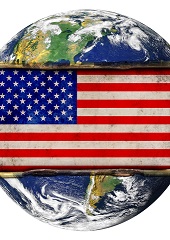Globalization, Americanization and Europeanization (Part III)
Will the United States be able to hold its central place within the world economy that it forged after 1945?
November 15, 2007

We now have ample evidence to support the assertion that, after the experience of the 1920s, Western Europe underwent a second and more intensive wave of Americanization.
This applied not only to economic structures and habits or, through NATO, to military institutions — but also to popular culture. Hollywood, jazz and pop music returned and captivated the young.
The key point, though, is that Americanization always involved a blending of U.S. practices with homemade ones. This blending was not uniform. There were areas where the American “flavor” was stronger than in others.
Still, foreign visitors would have no difficulty in knowing that they were in Munich, Manchester, Lyon or Bologna rather than in Austin, Texas or San Francisco.
Admittedly, there has been a fair amount of criticism of the Americanization paradigm. Western Europe’s turn to a mass production and mass consumption society is seen by these critics as part of a long-term modernization process that all industrial societies are supposed to undergo. Yet after several decades of debate, Americanization has not lost its plausibility.
Given the hegemonic weight of the United States in the transatlantic relationship, empirical research has found plenty of footprints of all sorts that the United States has left behind.
This applies also to Eastern Europe after 1989, the region that due to the Cold War was excluded from the American reconstruction and recasting effort after 1945 — and instead underwent a process of Sovietization.
To be sure, over the years the Soviet model of economy and society became increasingly discredited, and economic change toward a liberal-capitalist model had been established in countries such as Hungary or Czechoslovakia well before the collapse of the Soviet Bloc.
Nevertheless, there can be no doubt that the Cold War acted as a brake on East European development.
Even if the Sovietization of the Soviet Bloc economies had gone into reverse gear — as it was failing to fulfill the promises of a better life that the communist regimes, too, were holding out to their populations in competition with the West — it took longer to loosen the autocratic grip that the governments and communist parties had gained over these societies.
East-West competition also delayed change in the third world. It enabled the old colonial powers to hold on to their empires, and when independence finally came, the liberations’ struggles were often followed by civil wars.
The extreme violence of these wars radicalized small, determined minorities and traumatized the rest of the population — resulting in further physical destruction and widespread fatalism.
Some third world countries used their hard-won independence to enlist economic and military aid from either Moscow or Washington.
Others kept their distance from both and adopted a neutralist position.
In either case, they found it difficult to develop their potential and were also hampered by corruption, unequal terms of trade and often-covert outside interference.
No less important, the implosion of the Soviet Bloc coincided with the renewed dynamism that the American economy developed in the 1990s against the backdrop of the IT revolution, making adaptation to Western practices even more attractive to Eastern Europeans.
The same lure may be found behind the momentous changes that are now going on in East Asia, South Asia and parts of Latin America, where the retreat or the transformation of communist movements paved the way towards civilian mass production and mass consumption societies. These changes also gave way to an orientation toward the world market, as a multilateral trading system unfolded, still unbalanced but nevertheless offering advantages and the prospect of prosperity for all.
The most common term now being used to define economic and cultural developments of the past two decades would appear to be “globalization,” often interpreted as a resumption of the first wave of global interaction before 1914.
But just as this earlier wave cannot be understood without constant reference to Britain as the hegemonic power of the 19th century, on closer inspection recent trends look more like a veiled Americanization that began in Western Europe after 1945 and has been sweeping the globe since 1989.
Without denying that some of the technological and economic innovations that drive globalization originate outside the United States, it seems nevertheless clear that the most important advances, especially in communication and finance, continue to come from North America. The question now is whether the United States will be able to hold its central place within the world economy that it forged, step by step, after 1945.
Whatever we may think of the viability of the concept of globalization, what we certainly seem to be witnessing is a Europeanization, not of the world as in the 19th century, but of the European Union.
In a sense, the American attempt to divide Europe into an “Old” and a “New” part has produced the opposite effect, just as Washington’s unilateralism had led to a rallying of other power centers in other parts of the world.
We are also seeing a weakening of the process of cultural Americanization, owing to the power-political miscalculations of the Bush Administration and the resultant “imperial overstretch” (in the words of Paul M. Kennedy).
There was a moment after the end of the Cold War when the United States was indeed the sole “hyper power” that believed that others were irrelevant — and that it could throw its weight about unilaterally.
The war in Iraq has shown this notion to have been an illusion, so that we are once again moving into a multi-polar international system in which China, Russia, India and Europe can no longer be ignored.
Considering the havoc that Washington’s power-political unilateralism has wrought around the globe, this may not be a bad thing.
And yet the fading of the hegemon and the return of a 19th-century type “concert” of the great powers may also result in greater instability and conflict that could once more disrupt the process of globalization — as it did for the 70 years following the outbreak of World War I in 1914.
Some people speculate that this “concert” will again be replaced by a new hegemon, emerging this time from Asia. But this is a development that, if it ever happens, will take decades to play itself out.
Editor’s Note: Read Part II here.

